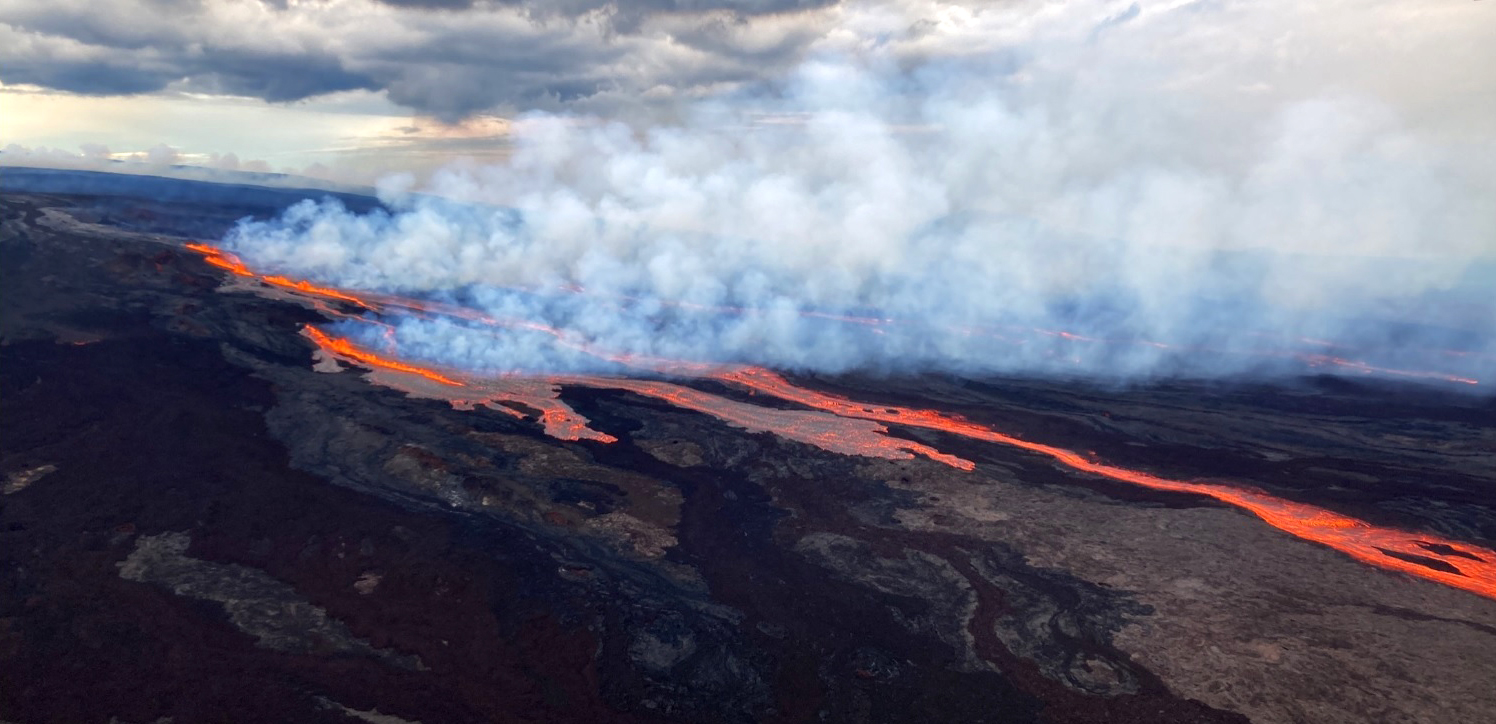
Mauna Loa, the world’s largest active volcano, began to erupt on Sunday, November 27, for the first time since 1984. NewsCenter’s Susanne Clara Bard checked in with San Diego State University geologist Vic Camp to learn about the science behind Hawai’i’s awakening giant.
Why is Mauna Loa considered the largest active volcano on earth?
The Big Island of Hawai’i is composed of five large shield volcanoes that are coalesced together. The tallest of these is actually Mauna Kea, which rises 13,803 feet above sea level. But the most massive is Mauna Loa, 13,679 feet above sea level. Keep in mind that the entire volcanic island begins on the seafloor, which is 19,700 feet below sea level, adding immensely to the total volume. Mauna Loa’s resulting volume, estimated at around 18,000 mi3, makes it the largest volcano on Earth.
Is it unusual for Mauna Loa to go so long without erupting?
Historically, Mauna Loa is a very active volcano. However, it ceased erupting in 1984 after the adjacent Kilauea volcano began erupting in 1983. Kilauea continued to erupt for 35 years — until 2018. Now that Kilauea has quieted down, Mauna Loa has again become active. This is fairly typical, as both volcanoes generally don’t erupt at the same time. This is because they share the same volcanic plumbing system at depth beneath the Big Island.
How old is Mauna Loa compared to its neighbors?
The surface lavas that erupted from Mauna Loa are geologically very young, with the oldest being only about 600,000 years. The age of the submarine eruptions beneath the volcano are older, probably about one million years.
All of the Hawaiian volcanoes are thought to be fed from a mantle plume, which is a conduit of hot rock with a presumed source at the core-mantle boundary, about 1,678 miles beneath the Earth’s surface. As it rises beneath the Pacific Plate, it begins to produce basalt melts that feed the volcanoes on the Big Island. As the Pacific Plate moves to the northwest, the underlying plume (or hotspot) remains essentially stationary. Within the next million years or so the island will move off the hotspot and a new Hawaiian island will appear above it. The process has continued over the past 70 million years to produce a linear chain of dormant and extinct volcanic islands and seamounts that get progressively older in age to the northwest, reaching all the way to the Aleutian Trench.
What are the different types of volcanic eruptions?
Volcanic eruptions can be highly variable in explosivity, from the most explosive Plinian-type eruptions of stratovolcanoes — exemplified by the 1980 eruption of Mt. St. Helens in Washington state — to the least explosive Hawaiian-type eruptions of shield volcanoes, exemplified by Mauna Loa. Explosive eruptions obliterate the magma into fine ash, sending small pyroclastic fragments and volcanic gases tens of kilometers into the atmosphere, while also devastating the surrounding landmass with deadly pyroclastic flows and volcanic mudflows. Instead, Hawaiian eruptions produce only very small eruption columns above the volcano, usually a kilometer or less in height. Whereas silica-rich Plinian-type eruptions are too explosive to produce lava flows, the more gentle Hawaiian-type eruptions can produce massive volumes of fluid lava that can flow great distances from the volcanic vents.
Did the Mauna Loa eruption have warning signs?
Volcanic eruptions are not entirely predictable, but more predictable than earthquakes. In fact, rising magma (liquid rock beneath the surface) is often first recognized by earthquake activity of a particular type (harmonic tremors) that signifies moving magma. As magma rises, it also decompresses, which allows dissolved gases in the magma to escape at the surface through small vents called fumaroles. If there is an abrupt increase in fumarole activity, this could also signify a potential eruption. Another indication is that the groundwater temperatures may increase due to rising magma, leading to increased steam eruptions and geyser activity. The ground itself may begin to bulge upward indicating very shallow magma rise near or under the volcano.
What are the potential hazards related to the eruption?
One may think that the non-explosive nature of Hawaiian eruptions makes them less harmful, but sadly there are dangers to be concerned about. There have been attempts to divert moving basalt lava, but these have not been very effective, so structures built in the path of moving basalt are generally destroyed, burnt to the ground or buried in hardened basalt. One can easily outwalk most basalt lava flows, but they are difficult to stop.
The source vents can produce eruption columns that rise a few hundred meters above the surface. These will be composed of globular masses of hot basalt liquid, many of which will harden in the air into pyroclasts (fragments of basalt bombs, rocks, and ash) before hitting the ground. Under high wind conditions these fragments can be drawn out into thin filaments called Pele’s hair (named for the Hawaiian goddess of volcanoes). Falling fragments can be dangerous near the vents. But the larger concern is atmospheric contamination from the production of so-called vog (i.e., volcanic smog), composed of sulfur dioxide and other volcanic gases that mix and react to form toxic compounds. Vog can be very acidic, so breathing it can result in respiratory problems for those living near the eruption.
More information about the Mauna Loa eruption is available from USGS.
Originally published on SDSU NewsCenter by Susanne Clara Bard